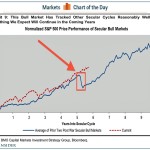The Most Bullish Chart You'll See Has A Big Stock Market Crash

More Charts
More and more Wall Street strategists* argue we should think about stocks as being in the middle phase of a long-term, multiyear, secular bull market.”Our view, which we have held since the market bottomed in 2009, is that the current bull market is secular, not cyclical,” Charles Schwab’s Liz Ann Sonders said. “Secular bull markets — like from 1949 to 1968 and 1982 to 2000 — are extended bull markets characterized by above-average annualized returns and generally less-dramatic downside risk.”
“Given our view that the market is transitioning toward the second stage of a secular bull market (“acceptance”), we believe US stocks are poised to provide average returns of 8-10% for at least the next three to five years, similar to historical norms,” Belski wrote in a Dec. 1 note to clients.
This is the kind of stuff that drives the bears and crash-mongers nuts.
To be fair, the folks touting the secular bull market also warn of volatility.
“[S]ince volatility is typically higher during this stage, we believe corrective phases are not out of the question and some years may be better or worse than the average (or even negative),” Belski said.
Sonders put it very bluntly at a media event Thursday, noting that the Black Monday crash of 1987 occurred in the middle of the secular bull market between 1980 and 2000.
On Oct. 19, 1987, the Dow plunged a breathtaking 22% in one day. Those days were so bad that you can see it in the chart like you can see the Great Wall of China from outer space.
For the long-term investor, even Black Monday 1987 was small compared with the returns the market eventually returned. Nevertheless, it’s a good reminder to stock market investors that the risk of a crash is very real.
BMO Capital Markets
*This is a position floated by RBC Capital’s Jonathan Golub, Morgan Stanley’s Adam Parker, FundStrat’s Tom Lee, BMO Capital’s Brian Belski, and Charles Schwab’s Liz Ann Sonders. This contrasts with folks like GMO’s Jeremy Grantham and John Hussman who warn of low or negative returns.
SEE ALSO: The Single Most Important Risk To Stock Market Investors
Continue reading here:
The Most Bullish Chart You'll See Has A Big Stock Market Crash

